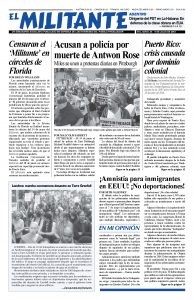In their never-ceasing drive for profits, rail bosses are forcing workers to drive longer and longer freight trains, endangering the safety of rail workers and those living in communities near the tracks. At the same time the bosses are pressing to cut the size of train crews.
“Companies have plenty of reasons to keep adding train cars,” the Wall Street Journal effused June 15, speaking on behalf of the rail bosses. “Long trains save on fuel and crews, reducing the cost of rail transportation.”
Train length on BNSF Railway averages some 8,000 feet — about one and a half miles — a company spokeswoman told the Journal. But “the railroad is testing cargo trains as long as 16,000 feet on its double track Southern Transcon route between southern California and Chicago,” the paper said.
Similarly, Union Pacific is running 14,000- to 15,000-foot trains every day, and plans to make them longer and longer, Cameron Scott, the company’s chief operating officer, told shareholders last month.
Trains of these lengths have a big and unpleasant impact on cities and towns they pass through. They block long strings of street crossings, often for an extended period of time, stranding commuters, school buses and all manner of traffic. There are no laws limiting train length.
Rail bosses have also been steadily whittling away at train crew sizes over the past several decades, claiming new technologies make it safe to eliminate workers. While 30 years ago union contracts set the crew size at five, today bosses are pushing for — and sometimes getting — the single worker “crew.”
Over the last few years there has been a growing string of major derailments affecting both freight and passenger trains. Worker fatigue and other challenges running longer trains with shorter crews are a big factor.
“When we had crews of five and shorter trains, we could walk the entire length and make sure the car numbers and cargo correctly matched what was on the manifest,” J.P. Wright, a CSX locomotive engineer for 12 years and freight conductor for 16 years told the Albany Times Union. “The only thing that regulated how many cars were in a train were union contracts.”
But the bosses’ push for the one-person crew is meeting resistance. SMART union members employed by BNSF Railway across the western two-thirds of the U.S. voted 5 to 1 in 2014 against an agreement regional union officials had made with the company for a one-person crew on freight trains. Workers won support, mobilizing union members and residents who lived along BNSF’s tracks, and they beat the demand back.
The increased dangers of derailments of trains carrying highly flammable material was highlighted last August when a 178-car CSX train derailed near Hyndman, Pennsylvania. Its cargo of molten sulfur and propane ignited, burning for two days. Over 1,000 residents were forced to evacuate the area. Nearly four months later a CSX train with 192 cars derailed, spilling 3,000 gallons of molten sulfur in Lakeland, Florida.
Recently residents near Princeton, Indiana, were forced to evacuate as train cars derailed and exploded June 17. Five days later in northwest Iowa a train derailment leaked oil into the river, resulting in some mandatory evacuations, the Des Moines Register reported.
The worst disaster took place in Lac-Mégantic, Quebec, where the Montreal, Maine and Atlantic rail bosses used the one-man crew and other cutbacks, leading to the 2013 derailment of a 72-car oil train that exploded and burned, leveling the city’s downtown and killing 72 people. The bosses and the Canadian government — which had OK’d the cutbacks — tried to frame up two union members, engineer Tom Harding and traffic controller Richard Labrie.
But they suffered a stinging defeat when the 12-person jury acquitted the two workers. “This is a victory for workers,” Gilbert Carrette, a member of the Lac-Mégantic Citizens and Groups Coalition for Rail Safety, told the Militant when the verdict was announced. “This tragedy, caused by company negligence and government deregulation of the rail industry, was placed on the shoulders of innocent workers.”
Bills have been introduced in the U.S. Senate and House of Representatives in recent years, including this January, that would require two-person crews on all freight trains, but they’ve been bottled up in committees to die.
“The BLET [Brotherhood of Locomotive Engineers and Trainmen] continues to oppose single-person freight operations as adverse to worker and public safety,” union President Dennis Pierce told the press, demanding passage of the bills.


